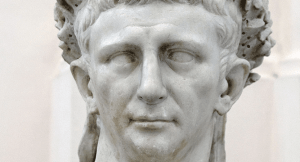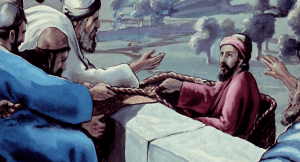In my last post, I wrote about my initial observations of Matthew’s, Mark’s, and Luke’s transfiguration accounts. The assignments for this week included researching Moses and Elijah as well as the meaning of the word transfiguration.
I started with an examination of the Greek word behind the English transfiguration. I found that the word in both Matthew’s and Mark’s accounts is the Greek word metamorphoō (Strong’s 3339). According to Strong’s Exhaustive Concordance of the Bible, this word appears four times in the New Testament. The New American Standard Bible (NASB) translates the word twice as transfigured, and twice as transformed.
Vine’s Complete Expository Dictionary defines the word as “to change into another form.” The dictionary then breaks down metamorphoō, showing that it is a compound. The first part is meta, referring to change, and the second part is morphē, referring to form.
Matthew and Mark both use the word, though Luke does not. Luke’s gospel targeted a non-Jewish audience. For that reason, Vine’s speculates that Luke “avoids this term, which might have suggested to gentile readers the metamorphoses of heathen gods.” Instead, his gospel explains that as Jesus prayed “the appearance of His face became different” (Luke 9:29).
Metamorphoō in Another Context
With Strong’s I learned that the translators rendered two of the uses of this word as transformed. These translations are in Paul’s letters to the Romans and Corinthians. We’ll take a look at each to see whether these passages give us any insight into Matthew’s and Mark’s use of the term.
In Romans, Paul urges his Christian readers “not [to] be conformed to this world, but [to] be transformed by the renewing of your mind” (Romans 12:2). In this request, Paul contrasts transformation with conformity. Christians are not to continue living as the world around them, but must change. That change happens “by the renewing of your mind.”
Vine’s points out that in this instance, “morphē lays stress on the inward change.” On the other hand, schēma, from the Greek syschēmatizō for conform, “lays stress on the outward.” Although this is interesting, we must be careful not to generalize.
If metamorphoō does indeed denote an inward change in Romans, we should not assume that it always denotes an inward change. In fact, for Peter, James, and John to have witnessed the transfiguration, the change in that instance had to be outward.
Transformed From Glory to Glory
The fourth use of this word may shed more light on the meaning of Matthew’s and Mark’s use of metamorphoō. One reason is that this particular usage occurs in a segment of the letter to the Corinthians that mentions Moses. Remember, Moses is one of the individuals in the transfiguration accounts.
In that passage, Paul states that Christians, “with unveiled faces, looking as in a mirror at the glory of the Lord, are being transformed into the same image from glory to glory, just as from the Lord, the Spirit” (2 Corinthians 3:18).
This is particularly interesting because the transformation relates to a glorious appearance. This is reminiscent of the mountaintop transfiguration. And as noted above, the individual 2 Corinthians mentions is Moses (verse 13), one of the significant individuals in the transfiguration accounts.
Moses and the Tablets of Stone
It’s always good to ask ourselves questions. Here is one that should come to mind as we read Paul’s letter to the Corinthians. What leads him to assert that Christians “are being transformed into the same image from glory to glory” (verse 18)? To find an answer, we should read the whole chapter.
Toward the beginning of 2 Corinthians 3 Paul had written of “tablets of stone” (verse 3). The word “tablets,” in a biblical context, should make readers think of the tablets containing the 10 Commandments. Paul’s discussion, then, seems to be connected to God’s covenants, both old and new. Verse 6 confirms this.
One covenant, Paul writes, is written on “tablets of stone,” as we saw earlier when we looked at verse 3. The other is written on “human hearts.” Paul goes on to say that “the letter kills, but the Spirit gives life” (verse 6). For readers who are more familiar with the Bible, this statement may well make them think of God’s promise of His Holy Spirit in Jeremiah.
[Bible students with less experience may still discover this link by looking at marginal notes in their Bibles. If you don’t have a study Bible with marginal notes, and if you are serious about Bible study, I recommend that you purchase one.]
In my study Bible there is a marginal note citing Jeremiah 31:33. The passage says: “‘For this is the covenant which I will make with the house of Israel after those days,’ declares the Lord: ‘I will put My law within them and write it on their heart; and I will be their God, and they shall be My people.’”
Moses and the Veil
It is after this comparison of the two covenants that Paul first mentions Moses and the “glory of his face” (verse 7). The people of Israel could not look at Moses because of this glory, “fading as it was.” Paul continues, writing about the veil Moses put over his face (verse 13).
Paul is obviously using an important Old Testament story to make a theological point. If we are not familiar with that story, we might not understand. At this time, then, it would be a good idea to find the passage that relates the whole story. Your margin may help. Mine didn’t, so I had to try a different tool.
Most of the time I tend to prefer actual books to digital resources, but not in this case. A good electronic search tool makes it easy to find passages relevant to your study. One reason is that digital search tools often allow you to search for more than one word at a time. This search feature automatically narrows the search results.
The Skin of Moses’ Face Shone
In this instance, I used Bible Gateway to look up three words together – “Moses,” “face,” and “tablet” – to find the story to which Paul referred. The search resulted in one verse, Exodus 34:29. I always like to read the context, so I skimmed through the chapter. The important details are in the last seven verses of the chapter (Exodus 34:29-35).
Moses had come down from Mount Sinai with the two tablets of the law. He did not realize at the time that his encounter with God had changed his appearance so that “the skin of his face shone” (verse 30). As a result, his brother Aaron, as well as other Israelites, “were afraid to approach him.”
Because of his changed appearance, Moses eventually covered his face with a veil (verse 33). It is this veil to which Paul alludes when he uses the word metamorphoō in his letter to the Corinthians. “But we all, with unveiled faces,” the apostle explains, “looking as in a mirror at the glory of the Lord, are being transformed” (2 Corinthians 3:18).
My Next Post and Your Assignment
I was a bit ambitious in my last post when I suggested that we look at the people in the transfiguration accounts. We’ve barely scratched the surface with our look at Moses, and we did not even get into what The Zondervan Pictorial Encyclopedia of the Bible has to say about him.
That’s because our examination of the usage of metamorphoō led us to a verse in which Moses appears. That’s the way it is with Bible study – you never know for sure where your exploration will take you, so you need to be flexible.
We’ll continue our study of Moses in my next post. If time permits, we’ll also take a look at Elijah. In the meantime, please feel free to add your comments. What have you learned so far about metamorphoō? Have you discovered any interesting points about Moses that could shed light on our study of the transfiguration?




